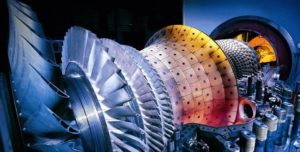POWER ULTRASONICS
Power ultrasonics defines a field of research where low ultrasonic frequency vibrations, usually in the 20-100kHz range, are used to affect an irreversible  change in a material or other medium. The range of applications in power ultrasonics is very wide and can involve excitation of effects such as heating, melting, fracture and cavitation, in processes such as joining, cutting, machining and cleaning. Our power ultrasonics research involves projects spanning materials processing, space applications and surgical devices. A common focus of the research is in the design and characterisation of ultrasonic devices in terms of the most beneficial vibration behaviour. Novel ultrasonic devices can be proposed that aim to eliminate or enhance nonlinear responses, depending on the application, providing insights and solutions for the control of nonlinear vibration characteristics. Penetration of difficult materials can be achieved by incorporating different mechanisms in devices; one we are researching relies on the conversion of high frequency vibrations of an ultrasonic horn to low frequency impacting of a tool on target material via a free mass, and another on combining longitudinal and torsional vibrations at the tip of the horn. Both provide advantages by removing the need to superimpose ultrasonic excitation onto a rotational motion, allowing non-rotational drilling, coring, cutting and insertion.
change in a material or other medium. The range of applications in power ultrasonics is very wide and can involve excitation of effects such as heating, melting, fracture and cavitation, in processes such as joining, cutting, machining and cleaning. Our power ultrasonics research involves projects spanning materials processing, space applications and surgical devices. A common focus of the research is in the design and characterisation of ultrasonic devices in terms of the most beneficial vibration behaviour. Novel ultrasonic devices can be proposed that aim to eliminate or enhance nonlinear responses, depending on the application, providing insights and solutions for the control of nonlinear vibration characteristics. Penetration of difficult materials can be achieved by incorporating different mechanisms in devices; one we are researching relies on the conversion of high frequency vibrations of an ultrasonic horn to low frequency impacting of a tool on target material via a free mass, and another on combining longitudinal and torsional vibrations at the tip of the horn. Both provide advantages by removing the need to superimpose ultrasonic excitation onto a rotational motion, allowing non-rotational drilling, coring, cutting and insertion.
MATERIALS, DESIGN AND MANUFACTURING
The Materials, Design and Manufacturing theme focuses on the use of numerical computation in understanding and optimising both material properties and design and manufacture processes. Materials of particular interest include: advanced, smart and nano-composites, adhesives, technical textiles and porous materials. Strong emphasis is placed on predicting the macro-scale properties of these materials from the underlying micro- and meso-structure. Understanding the role of the manufacture process in determining material behaviour is a key concern. The Design aspect of the research theme aims to reverse the typical design process by turning ‘design problems’ into ‘simulation problems’; a method known as computer-automated design. Here biologically-inspired, intelligent machine-learning algorithms are developed to allow manual design questions to be solved using faster, more efficient computer-controlled design codes. The Materials and Design themes can be combined to address issues in Manufacturing where the interplay between material behaviour and manufacture process determines both the quality and cost of the final products.
material properties and design and manufacture processes. Materials of particular interest include: advanced, smart and nano-composites, adhesives, technical textiles and porous materials. Strong emphasis is placed on predicting the macro-scale properties of these materials from the underlying micro- and meso-structure. Understanding the role of the manufacture process in determining material behaviour is a key concern. The Design aspect of the research theme aims to reverse the typical design process by turning ‘design problems’ into ‘simulation problems’; a method known as computer-automated design. Here biologically-inspired, intelligent machine-learning algorithms are developed to allow manual design questions to be solved using faster, more efficient computer-controlled design codes. The Materials and Design themes can be combined to address issues in Manufacturing where the interplay between material behaviour and manufacture process determines both the quality and cost of the final products.
Research across all these sub-themes is funded through various sources. Application areas for the research are broad including aeronautical, biomedical, energy, marine, military and automotive engineering.
AEROELASTICITY
The Aeroelasticity research examines interactions among aerodynamics, structural mechanics, and dynamics, spanning the fields of fixed- and rotary-winged aircraft as well as spacecraft. It also focuses on interactions between structural mechanics and dynamics. Increasingly, it is integrating controls and optimization as well.
 Researchers are developing computational methods for dynamics of systems of flexible structures that are interconnected. These are called multi-flexible-body dynamics. Focusing on rotary-winged aircraft aeroelasticity concerns, the researcher explores vibration reduction, improved methods for calculation of stability, methods for modeling composite rotor blades, and investigation of the effects of elastic coupling on blade performance and stability. Turning to fixed-wing aircraft, the group’s research focuses on computational methods, analytical and experimental studies of buffeting, and aeroservoelasticity of composite-winged aircraft with wings of high-aspect ratio. The group also employs high-order aerodynamics methods to capture the correct flow physics. This requires the marriage of computational fluid dynamics (CFD) and computational structural mechanics (CSM). Overall, the group’s work enables engineers to accurately and reliably predict the dynamics of complex flexible multi-body systems.
Researchers are developing computational methods for dynamics of systems of flexible structures that are interconnected. These are called multi-flexible-body dynamics. Focusing on rotary-winged aircraft aeroelasticity concerns, the researcher explores vibration reduction, improved methods for calculation of stability, methods for modeling composite rotor blades, and investigation of the effects of elastic coupling on blade performance and stability. Turning to fixed-wing aircraft, the group’s research focuses on computational methods, analytical and experimental studies of buffeting, and aeroservoelasticity of composite-winged aircraft with wings of high-aspect ratio. The group also employs high-order aerodynamics methods to capture the correct flow physics. This requires the marriage of computational fluid dynamics (CFD) and computational structural mechanics (CSM). Overall, the group’s work enables engineers to accurately and reliably predict the dynamics of complex flexible multi-body systems.